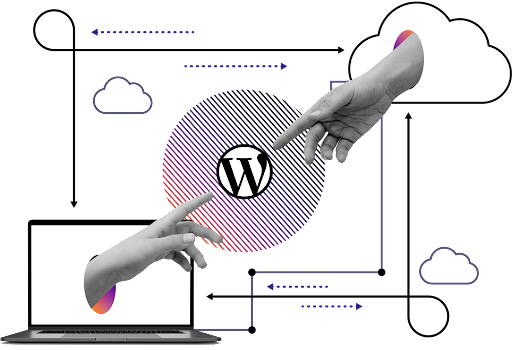How to Use WordPress Multisite To Power a Network
Image

WordPress multisite is a great tool to streamline website management while providing site owners with some versatility. At its best, multisite is the perfect solution for managing multiple websites at once.
But, a multisite certainly isn’t a one-size-fits-all solution. There are some caveats. Before we celebrate or dismiss it, let’s take a look at multisite and see what it’s all about.
At my company, 3 Media Web, we use multisite for a number of our clients, all with varying needs. I’ll share those experiences with you below so you can judge for yourself whether or not multisite is right for your company.
What Is WordPress Multisite?
WordPress multisite is a special WordPress feature companies and brands use to manage multiple websites quickly and easily from one single WordPress dashboard.
Say you have six different WordPress sites that are currently being managed separately. To access each of the sites you need to log out and log into a different dashboard. Installing plugins and themes is a separate process for each individual site.
It can take F-O-R-E-V-E-R.
With WordPress multisite, you can log in to one WordPress dashboard and quickly switch between any different number of sites via a dropdown menu.
Multisite can be a massive timesaver for companies that operate multiple websites. In fact, you can manage anywhere from two to millions of sites from the same WordPress installation if you are up to the challenge.
What Is Multisite Used For?
WordPress multisite is best used whenever there’s a need for a network of related websites.
Sounds broad, I know, but there’s a caveat that will help make more sense of it: All of the sites need to be similar in form and functionality. This is because, with multisite, all of the sites on the network will need to share a common theme and plugins.
(Truthfully, multisite isn’t exactly stellar for managing multiple websites if they don’t function similarly—check out Pantheon’s WordPress Multisite Best Practices and Decision Guide for more information on whether or not to choose this option.)
So, if you have a need to operate a series of websites that are somewhat related, but also somewhat different, multisite is worth checking out.
Here’s an example use case for multisite:
Let’s say a real estate agency wants to have one main site for the agency as a whole, while also giving individual agents similarly styled sites of their own. Multisite works great for that.
Likewise, universities can also find value in multisites. Using a multisite setup, educational institutions can operate their main website, while giving faculty, professors, and, in some cases, students the ability to produce individual sites specific to their departments and areas of study.
So, a prospective student could learn about the university by visiting myexampleuniversity.com, while enrolled students from, for example, the biology department, could access relevant departmental information at biologydepartment.myexampleuniversity.com.
And that’s just two of many use cases for a WordPress multisite installation.
WordPress Multisite: A Multilingual Website Powerhouse
For companies that need their website to display in multiple languages, WordPress multisite is a good solution.
In fact, at 3 Media Web, multisite is the preferred way to set up multilingual websites for our clients. This is especially true now in times of COVID-19, where having a multilingual website is more important than ever in bringing together worldwide audiences. Here’s an example:
We are currently in the midst of building a multilingual multisite for a security company that is planning to roll out a global virtual event later this year. With the onset of the COVID-19 crisis, the security company’s initial response was to cancel their event, which was originally scheduled as a live conference. Participants would have had to travel from different parts of the globe to attend.
Obviously, a live event is a non-starter during a pandemic. But fortunately, we had a solution for them: use multisite to host their much-anticipated conference online.
Rather than having people travel and congregate, they will be able to virtually attend the online conference. Thanks to a multilingual multisite, participants from different countries can easily be accommodated, regardless of the language they speak.
Beyond connecting global audiences, multilingual multisites have also proven valuable to marketers and SEO experts. Here's how:
Multisites Increase Organic Traffic
Numerous studies have been done on the impact a multilingual website has on traffic to your site. One example that comes to mind is when Kissmetrics founder Neil Patel translated his site into 82 languages. After about three weeks, Patel saw a 47% increase in traffic to his site.
Multisites Help Brands Earn Trust and User Confidence
If you’ve ever had to use Google Translate to translate a webpage for you, this point will already be obvious. Although Google does a decent job of translating copy, it comes nowhere close to a multilingual site that has been translated by an actual person who speaks the language fluently.
Even if your company is based in an English-speaking nation like the United States, don’t lose sight of the statistics. Bear in mind that:
- More than 43 million people in the US speak Spanish
- Over 350 different languages are used in American households
- Globally, the number of people who speak Mandarin Chinese is greater than those who speak English worldwide.
There are many widely spoken languages out there. Having a multilingual multisite is a great place to start to sell your products or services in a global market.
Unifying the Brand for a Technology Company’s Dispersed Subsidiaries with Multisite
Part of any good marketing strategy is detailed persona research. The more a marketer is able to hone in on who their target audience is, the more effectively they will be able to market to them. That much is a given.
Now, imagine you were a large company or corporation that produces a variety of different goods and services. The target persona for one of those products may be drastically different from another of your products.
Such was the case with another of our clients who operates a global business in technology. In addition to their core offerings, our client also has several subsidiaries operating underneath them.
To unify their branding and make managing a global network of blogs—one for each of their subsidiaries—more streamlined, we transitioned their website to WordPress multisite. Today, their corporate blog can target investors and partners, while their subsidiaries’ blogs produce content that targets their respective personas.
Considering that a consumer researching a specific product likely isn’t most interested in the parent company's internal operations, having separate blogs for subsidiaries aids in fine-tuning your marketing funnel. Operating a global blog network on multisite makes it more efficient for customers to find the information they are looking for without having to sift through dozens of blog posts that are not related to their needs. That lends itself to better user experience and better metrics.
For example, Xerox, which utilizes multisite, has dozens of blogs specific to a certain aspect of their business, such as:
- Newsroom Blog
- Fuji | Xerox Newsroom
- Small Business Solutions
- Channel Partner Connection
- Enterprise Matters
- Digital Printing Hot Spot
Healthcare Company Launches 10 Sites with a Unified but Unique Template on Multisite
In a third example, we assisted a healthcare company to set up a network of 10 websites using multisite. Our client has a number of health care facilities spread across the northeastern United States.
The facilities offer different specializations such as adult day care, hospice care, rehabilitation, and early education. Although they are all part of the same parent company, each facility operates under its own brand. As such, it was important to our client that all 10 of their sites use the same overall theme, but use the appropriate branding for each individual facility.
Using multisite, we were able to build a network of sites for our client, all with different domains and unique branding—the main driver being the consolidated management multisite offers for the backend, shared themes, and standardization of all the individual sites.
This approach is streamlined and consistent but still features personalization depending on each facility. Using WordPress Multisite instills a sense of brand unity while making the task of managing 10 unique websites much more efficient for our client.
Having Multisite Experience Goes A Long Way
WordPress Multisite is an ideal solution for many brands and companies, but it comes with a learning curve. Even though the WordPress dashboard will look and function similarly to its non-multisite counterparts, there are still some new features that are different. Plus, building out content and getting everything added to a new multisite can be a time-consuming process, especially if any of the websites on your multisite will be started from scratch.
If you’re looking for a trusted agency partner that can help your brand implement WordPress Multisite, contact 3 Media Web. And to learn more about Pantheon’s Website Portfolio Management Solutions, click here.


